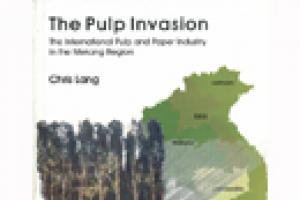Last year, presumably in an attempt to clean up its tarnished image, the World Bank produced a glossy brochure: "10 things you never knew about the World Bank". Number seven on the list is the claim, "The World Bank is a leader in the fight against corruption worldwide." The brochure adds, "The World Bank is working to fully integrate governance and anticorruption measures into its planning and operational work. The Bank is also committed to ensuring that the projects it finances are free from corruption."
Laos
Bulletin articles
11 February 2003
Publications
9 December 2002
This report was produced in 2000-2001 for the World Rainforest Movement, looking at the current state of the pulp and paper industry in the Mekong Region: Thailand, Laos, Cambodia and Vietnam. The research covers the extent of plantations and their social and environmental impacts in the region, the role of the various institutions in supporting the expansion of industrial plantations, and the patterns of local resistance to ecological damage and loss of livelihood.
Bulletin articles
7 September 2002
In July 2002, the World Bank released a "decision framework" on its involvement in the proposed Nam Theun 2 dam. The paper explains how the Bank intends to make a decision on whether or not to give a US$100 million loan for a political risk guarantee on the proposed 1,000 MW dam.
Bulletin articles
14 June 2002
Tree plantations are a growing problem worldwide and this is particularly clear to people living near the plantations. For instance, the Chief of Xiang Khai sub-district of Xaibouli district, in Laos, says: “Eucalyptus plantations are causing forest, soil and water resource degradation. I do not want anyone to grow any more eucalyptus trees in my sub-district.”
Bulletin articles
14 May 2002
Over the last decade the area of fast-growing tree plantations in the Mekong region has expanded dramatically. Villagers throughout the region have seen their forests, fallows and grazing lands replaced with eucalyptus, acacia and pine monocultures. A new World Rainforest Movement report, "The Pulp Invasion: The international pulp and paper industry in the Mekong Region", written by Chris Lang, gives an overview of the industry, profiles the actors involved and documents the resistance to the spread of plantations.
Bulletin articles
15 April 2002
On 28 February 2002, the International Finance Corporation, the private sector arm of the World Bank, approved a US$30 million loan to develop a gold mine at Sepon in Savannakhet province in Laos. The mine, which will be the largest mining operation in Laos, is 80 per cent owned by Oxiana Resources, an Australian mining company, and 20 per cent by Rio Tinto.
Bulletin articles
16 March 2002
Imagine the following situation: a company gives money to an environmental organisation. The company plans an enormous, massively environmentally damaging project in the tropics but agrees to provide funding to protect a nearby area of forest. Rather than opposing the project, the environmental organisation conducts studies on managing the protected area and recommends that the project goes ahead.
Bulletin articles
27 November 2001
Few large-scale industrial tree plantations have so far successfully been developed in Laos. However, companies and aid agencies are keen to promote them through changing Lao forest policy and through subsidies. The Asian Development Bank (ADB) is leading the push for plantations in Laos, particularly through its US$11.2 million "Industrial Tree Plantation Project" (see WRM Bulletin 43).
Bulletin articles
11 September 2001
The World Bank is edging towards making a decision on whether to award a US$100 million loan guarantee for the proposed Nam Theun 2 hydropower dam in Laos. Without the World Bank's guarantee commercial investors will not risk lending money to a joint venture project with the "formerly communist" regime in Laos. (See WRM Bulletin 44.)
Four years ago, the World Bank established an International Advisory Group (IAG) "to provide independent evaluation of the World Bank Group's handling of environmental and social issues related to the proposed Nam Theun 2 hydropower project."
Bulletin articles
12 March 2001
Not long ago, the Nakai Plateau and the surrounding forest in central Laos was home to tiger, elephant, otter, rhesus macaque, tawny fish-owl, crested kingfisher, Siamese fireback and brown hornbill. The communities living in the area use 28 different languages. A hunter-gatherer group, unknown outside the Plateau, speaks a language unrelated to any of the five major language groups found in the area. In 1992, a new genus of bovid, the Sao La, was identified in Vietnam. Its habitat also extends into the Nakai-Nam Theun National Biodiversity Conservation Area (NBCA) in Laos.
Bulletin articles
13 February 2001
Lao government officials, international aid agencies and forestry consultants are almost unanimous in claiming that large-scale reforestation is urgently needed in Laos to address the problems associated with deforestation. Yet, under the Asian Development Bank's US$11.2 million "Industrial Tree Plantation" project, forests are being further destroyed and replaced by monoculture plantations. The beneficiaries are private companies such as BGA Lao Plantation Forestry Ltd, which is currently establishing 50,000 hectares of eucalyptus plantations in Khammouane and Bholikhamsay provinces.
Bulletin articles
13 December 2000
The Government of Laos (GoL) has halted the Forest Management and Conservation Programme (FOMACOP) after the first five-year phase because of difficulties between the GoL and external actors including the World Bank over the management of logging revenues from the programme.

